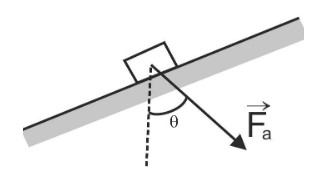
In the given figure a constant force \[\overrightarrow {{F_a}} \] of magnitude \[82.0\;{\text{N}}\] is applied to a \[3.00\;\;{\text{kg}}\;\] shoe box at angle \[\theta = 53.00\;\] causing the box to move up a frictionless ramp at constant speed. How much work is done on the box by \[{\overrightarrow F _a}\] when the box has moved through vertical distance \[h = 0.150\;\;{\text{m}}\]?


Answer
565.5k+ views
Hint: In this question, the concept of the conservation of the energy will be used, that is the total energy of the system remains constant. Here, the speed of the box is constant means there is no change in the Kinetic Energy so the change in the potential Energy is equal to the amount of work done.
Complete step by step answer:
In this question, firstly we consider the fact that there is no change in Kinetic Energy when the applied force \[{\overrightarrow F _a}\] causes the box to move up a frictionless ramp at a constant speed. As because the definition of Kinetic Energy says that there is no change in Kinetic Energy when a Force is applied in a frictionless surface:
\[ \Rightarrow \Delta K = 0\;\]
Where, \[\Delta K\] is the change in Kinetic Energy.
Thus, in the above scenario, the work done by \[{F_1}\] must be equal to the negative work done by the gravity.
So, according to the above statement,
\[ \Rightarrow {W_a} = - {W_g}\]
Where, \[{W_a}\]is the work done on the box and \[{W_g}\] is the work done by gravity.
Since the box is displaced vertically upward so work done on the box is given by
\[{W_{a}} = mgh\]
Here, the mass of the box is $m$, the height is $h$, and the acceleration due to gravity is $g$.
Now we putting the values as given in the question we get \[m = 3.00\;{\text{kg}}\],\[g = 9.80\;{\text{m/}}{{\text{s}}^{\text{2}}}\], \[h = 0.150\;{\text{m}}\]
So, we have,
\[ \Rightarrow {W_a} = \left( 3 \right)\left( {9.80} \right)\left( {0.150} \right)\]
After simplification we get,
\[\therefore {W_a} = 4.41\;{\text{J}}\]
So, the correct answer is \[4.41\;{\text{J}}\].
Note: It should be kept in mind that if an inclined plane is frictionless and force is applied to move an object, the Kinetic Energy is zero. If any value is considered, the whole problem will go wrong. Facts of negative work done should be kept in mind while solving the last part of the problem. When an object is displaced vertically upward, regardless of negative work done, we should consider it positive while solving with values.
Complete step by step answer:
In this question, firstly we consider the fact that there is no change in Kinetic Energy when the applied force \[{\overrightarrow F _a}\] causes the box to move up a frictionless ramp at a constant speed. As because the definition of Kinetic Energy says that there is no change in Kinetic Energy when a Force is applied in a frictionless surface:
\[ \Rightarrow \Delta K = 0\;\]
Where, \[\Delta K\] is the change in Kinetic Energy.
Thus, in the above scenario, the work done by \[{F_1}\] must be equal to the negative work done by the gravity.
So, according to the above statement,
\[ \Rightarrow {W_a} = - {W_g}\]
Where, \[{W_a}\]is the work done on the box and \[{W_g}\] is the work done by gravity.
Since the box is displaced vertically upward so work done on the box is given by
\[{W_{a}} = mgh\]
Here, the mass of the box is $m$, the height is $h$, and the acceleration due to gravity is $g$.
Now we putting the values as given in the question we get \[m = 3.00\;{\text{kg}}\],\[g = 9.80\;{\text{m/}}{{\text{s}}^{\text{2}}}\], \[h = 0.150\;{\text{m}}\]
So, we have,
\[ \Rightarrow {W_a} = \left( 3 \right)\left( {9.80} \right)\left( {0.150} \right)\]
After simplification we get,
\[\therefore {W_a} = 4.41\;{\text{J}}\]
So, the correct answer is \[4.41\;{\text{J}}\].
Note: It should be kept in mind that if an inclined plane is frictionless and force is applied to move an object, the Kinetic Energy is zero. If any value is considered, the whole problem will go wrong. Facts of negative work done should be kept in mind while solving the last part of the problem. When an object is displaced vertically upward, regardless of negative work done, we should consider it positive while solving with values.
Recently Updated Pages
Master Class 8 Maths: Engaging Questions & Answers for Success

Class 8 Question and Answer - Your Ultimate Solutions Guide

Master Class 7 Maths: Engaging Questions & Answers for Success

Class 7 Question and Answer - Your Ultimate Solutions Guide

Master Class 6 Maths: Engaging Questions & Answers for Success

Class 6 Question and Answer - Your Ultimate Solutions Guide

Trending doubts
What is meant by exothermic and endothermic reactions class 11 chemistry CBSE

Which animal has three hearts class 11 biology CBSE

10 examples of friction in our daily life

One Metric ton is equal to kg A 10000 B 1000 C 100 class 11 physics CBSE

1 Quintal is equal to a 110 kg b 10 kg c 100kg d 1000 class 11 physics CBSE

Difference Between Prokaryotic Cells and Eukaryotic Cells




